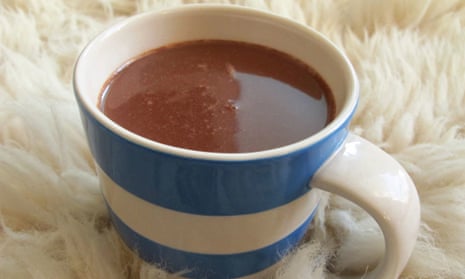Few beverages are as engrained in Americans’ collective childhood memories quite like hot chocolate. It’s a drink that reminds us of snow days, sledding, or a quiet day watching the snow fall.
What is it about a hot mug of chocolate in the depths of winter that brings a smile? More so then eating a bar of chocolate?
Well, for one, it’s hot and truly warms you up on a cold day. Plus, the luxurious taste and feel of drinking hot chocolate that then warms your whole body is exquisite! It is thick, silky and rich tasting!
Part of what might make a mug of hot chocolate so satisfying are the possible health benefits to be gleaned from drinking it. A flurry of medical studies on dark and hot chocolate have confirmed this – evidenced by the explosion of studies extolling chocolate’s virtues within the last decade. One states that hot chocolate actually increases the microcirculation in your skin, warming you. Another found that the myriad of chemical compounds contained in chocolate trigger the brain to release endorphins that induce feelings of feelings of calm. In all of these studies, a drinking chocolate or hot chocolate was used with the subjects (what a job that would be!)
Chocolate also contains many minerals, vitamins and biochemical compounds. Also, high quality chocolate contains cocoa butter, the vegetable fat found in cocoa beans, which is a natural energy source.
Chocolate was consumed almost exclusively as a drink throughout most of its 4,000-year history, starting in Central America and in the lowlands of Mexico with the Mesoamericans. Hot chocolate was also a luxury, generally only within reach for wealthy elites and royalty.
It was only until around 1850 or so that bars of eating chocolate started to be made. The price of cocoa and cocoa powder started to fall after the invention of processing equipment– like the hydraulic press, which extracts cocoa butter from the cocoa – and the expansion of cacao farming across the world’s tropical forests from 1850 to 1870.
All these factors united to bring hot cocoa and hot chocolate to the masses. But the association of chocolate with decadence and luxury still lingers hundreds of years later.
The style of hot chocolate we consume has also changed over centuries. Around the year 2000 BC, many Mesoamerican cultures began to experiment with making drinking chocolates. This early concoction was a thick, spicy concoction that was complex, lightly sweetened with honey and made with water – think chili peppers and flowers. From the 16th through 19th centuries, the Europeans added a more sweetness – sugar and other spices like cinnamon and perfumes. As time went on, more sugar was added and the spices were stripped away until it arrived at its classic American incarnation: sugary sweet, thin and without much actual cocoa. In Mexico, colonial and modern hot chocolate often contains almonds and cinnamon, and a whole lot of sugar, too.
In a letter to John Adams dated 1785, Thomas Jefferson wrote: “The superiority of [chocolate] both for health and nourishment will soon give it the same preference over tea and coffee in America which it has in Spain.”
Now, instant hot chocolate is ubiquitous around the world. But the tradition of drinking thicker, richer and less sweet chocolate is back en vogue. Cafes that serve spicy and flavored hot chocolates, which use very high quality chocolate as a base, are cropping up around the US – a much-welcome trend for chocolate connoisseurs.
The movement for direct trade has become more important to chocolate producers.
This allows most of the small producers around the world – in Central America, South America, the Caribbean, Madagascar and Indonesia – to work directly with cacao growers, paying well above the commodities and “Fair Trade” market prices. This movement not only means higher wages for the growers but also provides help for the cacao grower communities to build necessary infrastructure, such as health and education facilities. There’s also been a very strong interest over the last decade in cultivating and maintaining rarer varieties of cacao – yielding a wider array of choices available to niche consumers.
This also brings the original Mesoamerican flavors of chocolate into the present, coming full circle. Drinking rich, flavorful hot chocolate keeps me a little saner and brings a measure of calmness into my life – that is why I do it!
